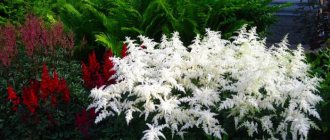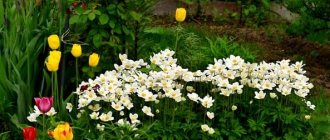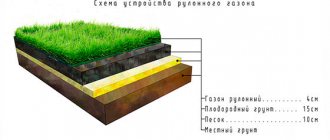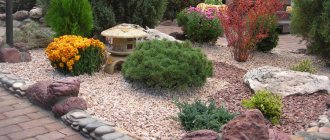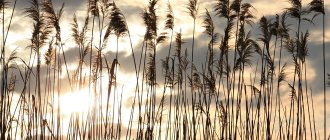Dwarf Canadian spruce - the plant is a variety of Canadian blue spruce. Under natural conditions, the height reaches 15-20 m. The slow speed of development is the main advantage of the coniferous tree.
Author of the article
Eduard Dmitriev
Florist and lover of indoor and garden plants.
Features of the plant
Decorative Konica has bluish-colored needles and a regular cone-shaped crown. This spruce reaches a height of up to 2-4 m. This allows it to fit into any landscape. The tree's growth in the first 10 years is 10 cm per year, and subsequently - only 3 cm per 12 months.
Safe and soft needles of conics are bluish-green in length and do not exceed 1 cm. The short roots of the plant are very close to the surface. Elongated conical cones sometimes appear on the tree, which are not like the fruits of other conifers.
The following table details the botanical features of Konika:
| Property | Description |
| Crown and height | Dense, cone-shaped; the plant grows up to 2 m, sometimes up to 5 m. |
| Needles | 10 mm, diamond-shaped in cross-section and not very prickly. |
| Fruit | Rarely appearing cone-shaped cones, 6 cm. |
| Escapes | With grooves, thin and light. |
| Trunk | Straight, brown, flaking in small spots. |
| Frost resistance | Up to -30° |
Canadian spruce Sanders Blue
Sanders Blue is a conical decorative variety, slightly narrower than Konika. It has bright blue needles. This is a real dwarf. Its growth is so slow that by the age of 10 it barely reaches 70 cm. The young shoots are quite numerous, have thin and short needles, which gives the Christmas tree a silvery-blue hue. Young needles always look brighter than old ones.
Canadian blue spruce grows well in a sunny location. Prefers moist, slightly acidic soil with good drainage. Differs in frost resistance.
However, during the first years after planting it needs protection from ultraviolet sunlight. Does not tolerate waterlogging well. In dry periods it requires artificial irrigation. Like other spruce trees, mulching is recommended.
It is worth considering and remembering that the tree is susceptible to infection by pine spider mites. In this regard, it is very important to have an insecticide on hand in order to treat the tree in a timely manner.
Unfortunately, the tree is not yet very popular in central Russia. But it is worth saying that if you follow the simplest agricultural techniques, you can get a wonderful small specimen of an ornamental Canadian spruce, which is perfect for a rocky hill, a small garden or a winter garden, where its bizarre shape and color can amaze even experienced gardeners.
Popular types and varieties
For the beloved qualities of Konica, breeders bred several of its varietal hybrids:
- A compact and round Baby with a height of 0.5 m. In its shape it is similar to Alberta Globe, and in its light-colored needles at the very beginning of growth - with Daisy White.
- Migold with a golden crown that fades only a little over time.
- Alberta Globe, with a rounded shape that turns into a dome-shaped one as the plant ages.
- Fresh and bright Sanders Blue with a silver-blue crown.
- Disember, with rapid growth (up to 15 cm per year), is usually used in solitary plantings.
Spreading
Thanks to its dense, fluffy, blue crown and unpretentious care, the Canadian variety has been successfully cultivated in Europe for a long time. It is known to Russian gardeners relatively recently, but it is already growing in all nurseries in the country and holds the sales lead. Special properties of the plant:
- increased frost resistance up to – 40 °C;
- invulnerability to sunburn;
- slow growth;
- natural immunity to disease.
And many other qualities distinguish Sanders Blue spruce from the numerous series of conifers, allowing it to be grown almost throughout the entire territory of Russia. Low prices for mature seedlings contribute to the realization of design fantasies and wide distribution. Through the Internet and retail chains, in addition to imported container specimens, gardeners also purchase freshly dug, zoned Christmas trees from our nurseries.
Application in landscape design
Gardeners willingly use the compact spruce Konica for landscaping their plots. A tree can become a real highlight in a flower garden or on a site, thanks to its decorative properties.
Hedge
A cozy natural fence made of Konica spruce does not require pruning for the first 8-10 years. Alberta Globe is most suitable for hedges.
This representative of conifers is not afraid of:
- diseases;
- pests;
- frost.
The article contains photos of Konika spruce in landscape design.
A hedge of low-growing Konika:
- enriches the air with life-giving phytoncides;
- will retain dust and precipitation;
- will protect from the wind.
Solitaire plantings
When planted alone, the Canadian conifer does not stretch upward to follow the sun's rays, but forms a beautiful and dense crown. The tapeworm is planted taking into account the background composition. Konica in this design will look better on a well-groomed area.
A single gray Canadian mini-spruce is planted in the soil or in a pot. With option 2, it is convenient to move the Konik around the site. In the ground, the tree will remain in the same place all the time.
Compositions with perennials
Konika spruce is quite common in landscape design due to its decorative value and height. It feels great both when planted alone and nearby with other perennials. Canadian Konica is often used in mixborders, along with perennial plants.
They look great with bluish-green needles:
- lilies;
- irises;
- roses.
Canadian spruce Alberta Globe
This variety is a coniferous evergreen shrub with a spherical shape, which is a mutation of the popular Konica. The tree grows very slowly. The height of an adult plant is 1 m with 1 m in diameter. The soft radial needles are green-yellow at an early age and bright green when old. Such needles form very dense, rounded needles.
Alberta Globe prefers to grow in a sunny area, but can also develop in partial shade. This variety has a shallow root system, so it is very important not to let the soil dry out. The Christmas tree responds well to watering in the evening. Like other conifers, it is recommended to mulch with natural materials, which allows you to maintain soil moisture and looseness at an optimal level. The spherical variety of Canadian spruce will be an excellent addition to oriental-style compositions; it looks great in rocky and heather gardens. In addition, it can be used as a potted plant.
Features of plant propagation
You can propagate the Canadian coniferous plant using:
- seeds;
- cuttings;
- ready-made seedlings, which are usually sold in pots.
Cuttings for planting are taken from adult spruce trees in June. This propagation material is separated along with the bark from the lowest branches. The cut cuttings are kept in a stimulating solution for 2 hours. The branch planted in the substrate is constantly watered with a stimulant, after which the soil is loosened.
Watering and fertilizing are repeated once a month. Together with them, the condition of the seedlings is checked. Dry ones are removed. After 5 years, the cutting, which has increased in size to 1 m, is transferred to its permanent location.
Well-ripened seeds taken from cones in November are prepared before planting. To do this, they are soaked for 2.5 hours in a solution of potassium permanganate. Then the planting material is placed in a container with sand and put away in a dark and cool place.
In February, the seeds are planted in peat with sand and watered. The containers with them are placed in a warm and bright place, not forgetting to put glass or film on top. Sprouts from seeds hatch after 3 weeks. Seedlings are transferred from containers to open ground in May or June.
Successfully selected seeds for planting (for even greater success, it is better to purchase them in a special store):
- germinate well;
- tolerate transplants well in the future;
- the first 5 years do not suffer from drying out and rot.
Konica can be propagated using ready-made seedlings that are sold in pots. Before purchasing them, choose the optimal place for planting and prepare the soil. If the purchased specimen has roots covered with soil, then it is transferred to the soil on the site at any convenient time.
Good Konica seedlings are sold in pots with a diameter corresponding to their crown circumference. In too small flowerpots they are very crowded, which is why their roots gradually die. The greenery of the Christmas trees in the purchased containers should be healthy and juicy.
A plant without a container will have to be planted immediately after purchase. Exposed roots should have a ball of earth on them. During transportation, it is covered with a damp cloth. The purchased specimen should not have dry branches or signs of damage.
Before planting a Konica seedling, the soil is enriched with organic fertilizers and dug up. Instances with a closed root system are moved into the ground in the summer, and those with an unprotected root system in the fall.
A 5 cm layer of drainage is placed in the prepared recess for planting. A mixture of:
- a small amount of organic fertilizer;
- leaf soil;
- sand;
- peat;
- turf.
Next, a small hill is formed in the hole. A seedling is placed on it. Having sprinkled the seedling with the remaining soil, it is watered with 10 liters of water. Then the tree trunk circle is mulched with peat. The seedlings are planted to the depth of a clod of earth on the roots. If this part of the spruce is open, then its neck should be at surface level.
Growing Canadian blue spruce from seeds
A very interesting question. First you need to wait for cones from Konika, which is very problematic. Its seeds do not go on sale, but if you advertise for purchase yourself, of course, they will be found. It’s just that what it will actually be is unknown.
The gardener will be very lucky if he finds the seeds of the Canadian spruce Konika, and they:
- will germinate safely;
- seedlings will undergo several transplants at a young age;
- will not die in the first 4-5 years from blackleg, fungi, dry soil or one of a thousand other reasons.
There is no guarantee that the result will be as expected. The fact is that most of the seedlings, when they grow up, will turn out to be ordinary species of Canadian spruce. The rest are unlikely to have all varietal characteristics. If you are very lucky, 15-20 years after sowing the seeds it will be possible to announce the creation of a new cultivar.
Bottom line! In short, Konica does not reproduce by seeds.
Rules of care
Konica requires proper care to improve its decorative qualities, even though it is completely unpretentious. This conifer loves moist and fertile soil all year round, and sometimes needs shading. But at the same time, the plant does not need decorative pruning of the crown at all.
Spruce purchased in a tub at home:
- installed away from batteries;
- constantly trying to shade;
- regularly sprayed in heated rooms;
- placed near humidifiers;
- on glazed balconies or loggias in winter they are covered with insulation;
- keep for no more than 4 years, after which the tree is moved outside, into the soil.
Konika placed on a radiator will soon turn yellow and lose its needles. A tree in a pot should not be over-moistened or over-dried. The container with the plant must be constantly rotated so that each side sees the sun.
As the spruce grows, it is transplanted into a larger flowerpot and acidic soil is added there. It is strictly forbidden to treat seedlings in pots with aerosols to add shine.
It is better to place pots with conifers where the sun shines only in the evening. This way the plant will be able to avoid burns from its rays. For the winter, the seedling is transferred to a balcony or loggia. The optimal temperature during this period is no more than +10° and no less than +3°. Spruce indoors is watered with warm, settled water, and its needles are sprayed up to 5 times a day.
Konica spruce is used in landscape design as a compositional component for creating decorative objects. It can even be planted in containers and kept indoors. In this case, this tree often acts instead of a New Year tree.
Rules and terms of landing
Canadian low-growing spruce is planted in spring or autumn (from April to May or from August to September) so that by winter it becomes strong and well-rooted. But this only applies to the Middle Zone. In the southern regions, transferring the seedling to the ground should still be done in the fall.
A plant planted in these places in the spring will definitely get burned. It is prohibited to transfer trees from containers into the ground when young growth is forming.
Site selection and soil preparation
The most favorable places for Canadian conifer are considered to be the semi-shaded northern or eastern parts of the property. Konika planted in this way will be reliably protected from dry winds and the scorching midday sun.
On the western or southern sides of the site, young Konica is often watered and must be covered with spunbond for the winter to protect it from spring burns. If this is not done, the top of the plant burns and the needles fall off without further restoration.
It is optimal to plant konica in loam, away from groundwater. The planting hole for the plant is dug according to the size of the container from which the seedling will be transferred. More precisely, the recess is made 1.5-2 times larger than the shoot pot.
The bottom of the seat for Konica is covered with drainage, for which the following is used:
- brick chips;
- expanded clay;
- sand.
After drainage, the hole can be filled:
- vermiculite;
- sand;
- pine litter mixed with peat;
- ready-made soil for conifers.
Every sq. m of poor soil is treated with 100 g of a mixture of potassium salts and superphosphate.
Konika spruce is often used in landscape design to create hedges. Such a fence will perfectly protect the courtyard of the property from gas pollution and the scorching sun. It is also customary to decorate balconies and terraces with this coniferous plant. And it will look no less interesting on children's playgrounds.
Watering
In hot weather, young or recently transplanted trees are watered once every 7 days. For each bush, water consumption should be at least 10 liters. The irrigation liquid should be slightly warm, not icy. In the summer, the crown of plants must be additionally irrigated with a hose or diffuser to clean and moisturize.
Top dressing
Konica begins to be fed from April to June. Fertilizers for this purpose are chosen specially, specifically for coniferous plants. In the first half of the month after planting, the spruce is sprayed with Ferovit.
It is also doused with stimulants:
- Epin;
- Heteroauxin;
- Herbamin.
Among the organic fertilizers for Canadian spruce you should like:
- dolomovite flour;
- potassium magnesia;
- compost;
- vermicompost.
To strengthen the roots, you can add the following to the water for watering Konica:
- Agricole;
- Novofert;
- Plantafol.
In the spring, to improve the health and growth of spruce, the plant is fertilized:
- Aquarin;
- Master;
- Agricol.
Loosening and mulching
During particularly dry periods, the soil that begins to harden under Konika must be loosened. Mulching is done during planting and then before each winter.
To do this, the ground under the spruce can be covered:
- sawdust;
- leaves;
- peat.
Loosening must be done very carefully so as not to accidentally damage the roots located close to the surface. This manipulation must be completed with mulching so that the tree trunk circle under the plant does not become overgrown with weeds and does not dry out.
Trimming
Thanks to its natural and original shape, Konica does not need pruning at all. But if you really want to give the plant a different look, then you can trim it with sharp pruning shears if you wish.
Before and after winter, the spruce is examined for:
- damage;
- frostbite;
- burning;
- dryness
Branches with these signs are cut off. At the end of spring, burnt branches without needles or with their remains can be frequently watered with a hose. This action will quickly awaken the buds on the branches, due to which new shoots with needles will grow. After spring topiary (in March-April), sections of branches are coated with fungicidal agents.
Konika spruce in landscape design looks good in rockeries and rock gardens. Flowerbed owners also like to place it in the background of their creations. Under good conditions, this conifer can live up to 500 years.
Resistance to diseases and pests
Constant feeding and properly selected soil will help protect the health of Konika.
The blue miniature spruce will become more resistant to pests and diseases if:
- timely prevention;
- competent care;
- correct agricultural technology.
Common problems with Konica include:
- Schutte's disease, which affects needles and is fungal in nature. Infected needles first turn black and then fall off. If these signs occur, the spruce is immediately sprayed with Trichodermin or Alirin-B. Trees with an advanced form of the fungus are destroyed so that other plants do not become infected.
- Tracheomycosis of roots. This type of fungus usually affects young trees. Their needles gradually turn red and fall off. This disease is incurable. The affected specimens are destroyed, and the ground where they grew is covered with dissolved copper sulfate.
- A fungus called rust that attacks the needles of plants. They fight it with the help of Vectra or Glyokladin.
- Infestation with bark beetles, from which there is no escape. But you can repel these harmful beetles by constantly spraying the tree with fungicides.
- Damage to the larva of the false scale insect. It is destroyed with Bi-58 solution.
Konik is treated against the invasion of other pests by:
- Confidor;
- Fitoverm;
- Aktara.
People are afraid of these drugs:
- sawflies;
- spider mites;
- shoot moth;
- green aphid.
For preventive purposes, fungicidal treatment of Konica is carried out every spring. If pests are detected on the plant, spraying is carried out until they are completely destroyed.
Is it worth planting Konica?
The answer is clear - no. This spruce is not for Russia. It will not grow and develop normally in Belarus or Ukraine. The variety was created for countries with a humid climate, where temperature changes are rare and spring is smooth and predictable. But who will stop it?
Caring for the Canadian Konica spruce is difficult; it requires constant attention. And cleaning an adult tree takes a lot of time and can be harmful to health. That is why even experienced gardeners often try to avoid this procedure by any means.
Irrigation and treatment of the crown with epin often begin only when the problem has not only manifested itself, but it can no longer be ignored. As a result, Konika turns into a disgrace to the site; moreover, it does not clean the air, but pollutes it. Spruce becomes a breeding ground for diseases; pests live and multiply in the dense crown. Then all this spreads throughout the area.
Preparing for winter
At the end of October, to protect the roots from frost, the trunk circle of the dwarf spruce is sprinkled with mulch. Small and young specimens of the plant are additionally covered with spruce branches. Mature trees are no longer so afraid of frost, but they should be wrapped in burlap or cardboard at the end of February, without affecting the lower branches. These steps are taken to protect Konica from the spring sun.
Unpretentious and hardy Canadian spruce of the Konica variety is used to improve home interiors and outdoor areas. In the landscape, conifers often act as a natural windbreak for other smaller plants. Designers like to highlight the beauty of neighboring plantings with this tree.

